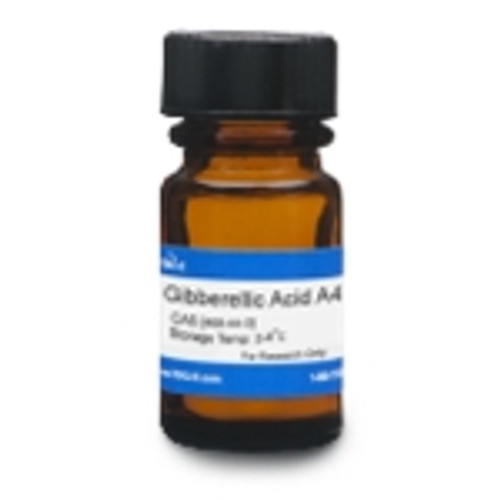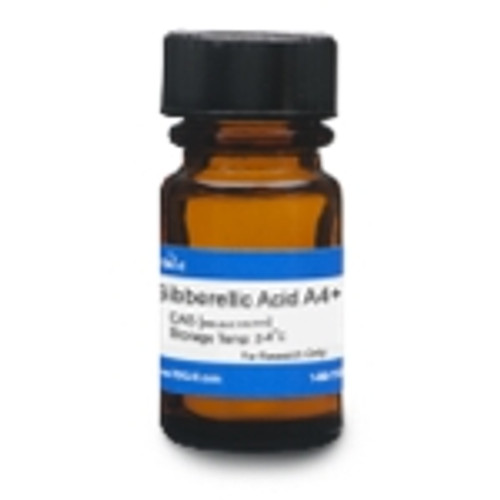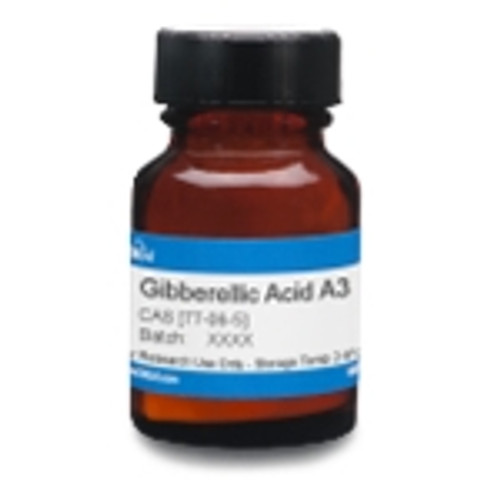Gibberellic Acid A4 is a natural, endogenous, plant growth regulator involved with plant growth, germination, elongation, and flowering. Bioactive diterpenes biosynthesized through complex pathways, gibberellins control diverse aspects of plant growth and development. The majority of genes that encode Gibberellic Acid biosynthesis have been identified.
| Mechanism of Action | Gibberellins are highly expressed in embryos. During this stage, starch serves as the primary energy source and is subsequently degraded by Gibberellin-induced activity. |
| Plant Biology Applications | Gibberellic Acid is used to promote cell division and cell elongation, seed germination and flowering in long-day plants (Raven et al., 1999). In addition to tissue culture applications, Gibberellic Acid is used in strawberry to control growth and flowering for out of season cropping (Paroussi et al., 2002). |
| Eukaryotic Cell Culture Applications | Gibberellic Acid has documented anti-inflammatory activity and can induce A20-like zinc finger proteins in plants. Primary airway nasal epithelial cells and a human bronchial epithelial cell line (16HBE14o-) were used to evaluated its anti-inflammatory activity. The induction of A20 by Gibberellic Acid could attenuate inflammation at least in part through its effect on NF-κB and IκBα. This product or its derivatives could potentially be developed into an anti-inflammatory agent for diseases associated with A20 dysfunction (Reihill et al, 2016). |
| Cancer Applications | The Gibberellin derivative 13-chlorine-3,15-dioxy-gibberellic acid methyl ester (GA-13315) was found to have antitumor and antiangiogenic activity in vitro and in vivo. IC50 values were 0.13-30.28 µg/ml in 12 human tumor cell lines, and 14.2 µg/ml in peripheral blood mononuclear cells. The antiangiogenic activity (reduced chemotactic motility and capillary-like tube formation) contributed to its anticancer properties (Zhang et al, 2012). |
| References |
Paroussi G, Voyiatzis DG, Paroussis E and Drogoudi PD (2002) Growth, flowering and yield responses to GA3 of strawberry grown under different environmental conditions. Sci. Hort. 96:103–113 Yamaguchi S (2008) Gibberellin metabolism and its regulation. Annu. Rev. Plant Biol. 59:225–51 Yancheva SD, Golubowicz S, Yablowicz Z, Perl A and Flaishman MA (2004) Efficient Agrobacterium-mediated transformation and recovery of transgenic fig (Ficus carica L.) plants. Plant Sci. 168:1433–1441 Wang Q, Litle CHA, Sheng C, Oden PC and Pharis RP (1992) Effect of exogenous Gibberellin A4/7 on tracheid production, longitudinal growth and the levels of indole‐3‐acetic acid and Gibberellins A4, A7 and A9 in the terminal shoot of Pinus sylvestris seedlings. Physiol. Plant. 86(2):202-208 Zhang Y et al (2012). Antitumor and antiangiogenic effects of GA-13315, a Gibberellin derivative. Invest New Drugs 30: 8–16 PMID 20711631 |








